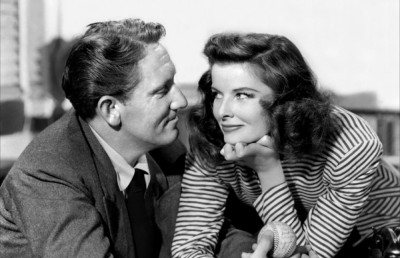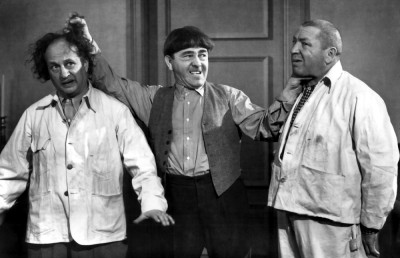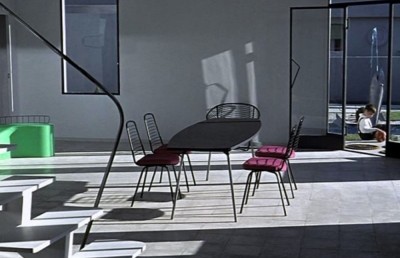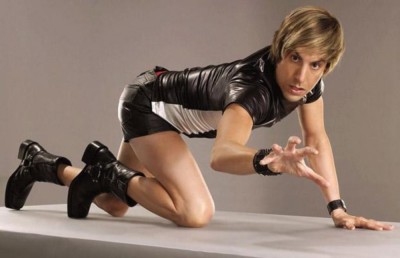Bergson’s Comic Theory and Jacques Tati’s Les vacances du Mr. Hulot
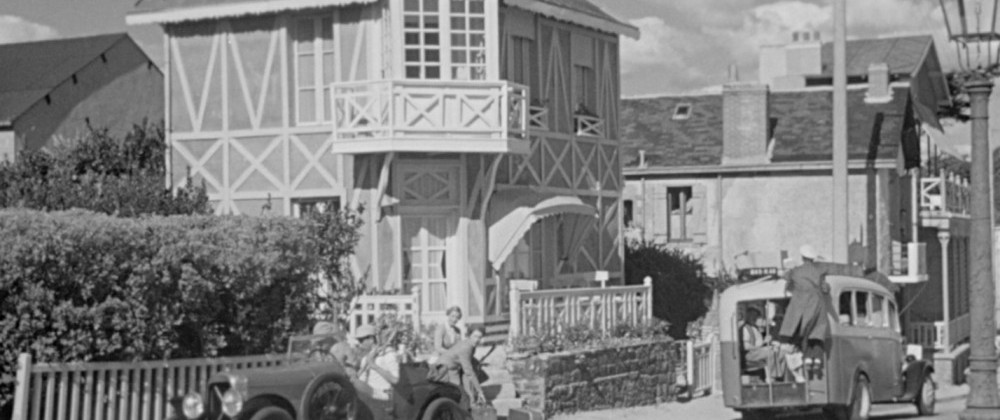
In 1900 French philosopher Henri Bergson set down his thoughts on the purpose of comedy and its principles. In 1953 French filmmaker Jacques Tati made a comic film on the mores and manners of a microcosmic selection of people at a hotel resort area. Conceived fifty-three years apart, Bergson’s monograph Le Rire and Tati’s film Les Vacances de Monsieur Hulot display a remarkable affinity of comic mind. As a philosopher Bergson countered Mechanism and Materialism with his eloquent form of Vitalism and the ‘élan vital,’ Bergson’s notion of an original life force which eludes science and logic and can be understood only by the faculty of intuition (Bentley, p.135). With the 18th century Industrial Revolution in full fling, Bergson’s essay, while voicing his comic theories, had an underlying purpose: to make people aware of the dehumanizing con¬sequences of a mechanized society. Although Tati’s film lacks the philosophical goals of Bergson’s writings [1], it has an underlying tone of satire which echoes this same sentiment of social stagnation. The similarities become clearer when Tati’s comic mechanisms are compared to Bergson’s. Before making these direct comparisons I will discuss Bergson’s mechanism of laughter.
The central concept in Bergson’s theory is the sublimely rich and comically evocative, “something mechanical encrusted upon the living.” Although this is the focal point of his theory it is amplified by several other observations and comments. His study is divided into six sections: comedy in general, comedy in form, comedy in gestures and movements, comedy in actions and sit¬uations, comedy in words, and comedy in character. Since it does not apply to Tati, I will exclude Bergson’s section on comedy in words.
In the opening of his essay Bergson notes that because the comic spirit has a logic of its own it will be treated as a “living thing.” He follows with several generalizations that grow from this thought.
1) Comedy, regardless of its end result, belongs strictly to the human domain; there must be a kinship to the human mind/body, whether it be in physicality, expression, attitude, or gesture.
2) Comedy is aimed at the intellect and can function only when emotions are put aside, when there is an “emotional anesthesia of the heart”.
3) Comedy works better in a group, and therefore merits social significance.
4) Society requires of an individual an “elasticity” of mind, body, and character. Without this range of adaptability the individual will not be a vital and thriving member of society (and prey as a comic foil).
And one final and crucial generalization.
5) Absentmindedness is one of the most important elements in comedy and in the formation of the comic character. It is the ‘fountainhead’ of comedy.
In the chapter entitled “The Comic Element in Forms” Bergson posits the key notion (which works as both a literal, poetic, and visual image) of the basis of his comic theory: “Something mechanical encrusted upon the living.” The imagination (as opposed to reason) sees in every human form a free and transient soul shaping matter. The soul passes on some of its supple qualities to the body it animates; this intangible quality which is passed into matter is called gracefulness. Matter, being inert and machine-like however, cannot convert this gracefulness to the body and what we end up with is a mechanical and lifeless exterior (the body). Bergson takes this metaphysical idea of inert matter on the supple soul and extrapolates it into gestures, movements, forms, etc.
In the chapter dealing with gestures and movements, “The Comic Element in Movements,” Bergson expands the idea of something mechanical encrusted upon the living into three directions. Mechanical rule number one states that comedy results when something rigid is imposed upon the mobile body, awkwardly attempting to follow its lines and copy its gracefulness. Examples include rigid clothing and disguises. [2] In treating society as a living thing, it too is susceptible to the rule, hence a cumbersome ceremony (a funeral, a wedding, etc.) is to the social body what rigid clothing is to the living body.
Rule number two is a variation of inert matter imposing itself on the soul –the body imposing itself on the soul. In this case “the soul [is] tantalised by the needs of the body….” [3] Through some bodily defect (a sneeze, a toothache, a slurred word) we are redirect¬ed from the moral to the physical. Rule number three states: “We laugh every time a person gives us the impression of being a thing (Bergson, p. 97). Examples include being tossed into the air like a football, being thrown out of a can¬non, posing still for a photograph, etc..
The second chapter deals with the comic element in actions and situations. Bergson sees certain actions, games, and situations traceable to childhood as things which have become imbedded in our mind as being funny (not unlike those childhood fears that Freud says ‘return’ to us an ‘uncanny’ sensations later in life). They include: the Jack in the Box, the Dancing-Jack, and the Snow-Ball effect. The Jack-in-the Box is the struggle between two equally stubborn elements, one being mechanical and eventually giving in to the other force. The Punch and Judy, a variation of the Jack-in-the-Box, is the spring like repetition of an event, like being knocked down and getting up again. The Dancing Jack is an illusion of freedom; a freedom which, seen from another viewpoint, reveals the controlling “strings” of someone or something else. The Snow Ball is a causal sequence of events, a chain link, which progresses from minor to major, from insignificance to chaos. It is momentum gone astray, like the snowball rolling down a hill, the falling dominoes, or a tumbling house of cards. The law for these examples states that any arrangement of an act or event is comical if it simulta¬neously gives the appearance of life and the distinct impression of a mechanical arrangement.
According to Bergson the living is distinguished from the mechanical by its transient evolution, always moving, progressing, and pushing on, never repeating itself. There are three processes which are the counterpart to this flux of life: repetition, inversion, and the reciprocal interference of series. The first two are self explanatory, but the third, which is a source for a great deal of comedy, needs expounding. To quote Bergson:
A situation is invariably comic when it belongs simultaneously to two altogether independent series of events and is capable of being interpreted in two entirely different meanings at the same time (p.123)
This idea is reworked by Noel Carroll as one of his key comic descriptors in his essay “Notes on the Sight Gag,” when he refers to it as the “mutual interference of interpenetration of two (or more) series of events (or scenarios)” where an event can be seen or interpreted in two wholly plausible yet contradictory ways. In the cinematic sense the gag involves an event in which the (usually) audience reads the event one way (usually the correct way) while the hapless comic character reads it in another (faintly plausible yet wrong) way.
These three processes transform life into a repeating mechanism by way of “reversible action and interchangeable parts” (Bergson, p.126).
Bergson devotes more space to the chapter on the comic in character than to any other. It is impossible to pare down all the thoughts in this chapter to a few words, therefore I am admitting oversights in favor of what I believe to be the general points and the ones which best apply to Tati’s film.
Absentmindedness is one of the essential and funniest traits of a comic character. When coupled with automatism and an indifference to social life a character develops a systematic absentmindedness which allows him to go through life without troubling himself with any deep social interrelations. Anytime a person is unsocial he becomes prey to humor. Comic faults and vices are exposed through social gestures [4] (attitudes, movements, mannerisms). Gesture is to comedy what action is to drama.
In a nutshell, I have enumerated the principles involved in Bergson’s mechanism of laughter. I will now apply some of these principles to Tati’s Les Vacances de Monsieur Hulot.
In complying with mechanical rule number one (something rigid imposed on the body) the vacation itself is a cumbersome ceremony imposing itself on the social body. The vacationing people appear stiff and bound by the “rules” of their vacation (what to do and when). When they are seated in the dining room the camera captures them in a high angle to reveal a deathly still and silent group of people waiting for their eating cue –when the two waiters begin to quarrel. They are so bound by rule and habit that one group can only eat at the same table they dined at last year. In individual terms the rule applies well to Hulot, who is continually “disguising” his body with an array of costumes: his one-piece bathing suit, his horsing outfit, his tennis outfit, and his pirate costume.
The rule most often employed by Tati is mechanical rule number three: when a person gives us the impression of being a thing. At the beginning of the film Hulot opens the door to the hotel, letting in a gust of wind that disrupts the seated vacationers (a figurative ‘breath of fresh air’ into the stale proceedings); this Hulot-inspired disruption will become a recurring comic structural element in the film. There is a subsequent medium shot of a man holding a book in his left hand, pages fluttering in the wind, and a cane in his right hand keeping his hat fixed on his head. The man is so still that he might as well be a dummy. The shot lingers, with no apparent reason, for five or six seconds. Could the image be a symbol of the mannequin-like people who will shortly populate the film?
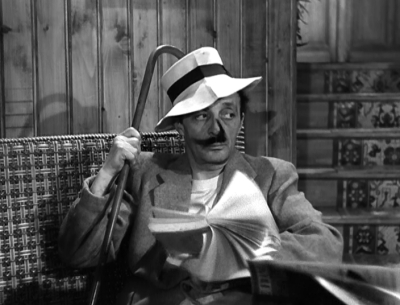
Here are some examples of Tati expressing rule number three: when a person gives us the impression of being a thing. A group of tourists are exercising on the beach, moving to their instructor’s directions. As their instructor stops to examine something Hulot is carrying, the class remains rigidly frozen in a ludicrous bent pose, awaiting the next instruction, like wind-up puppets who have come to the end of their wind. In a similar sense, a man arranging staging his family for a photo leaves to answer a phone call, and the family remains perfectly still, giving the impression of a framed photo.
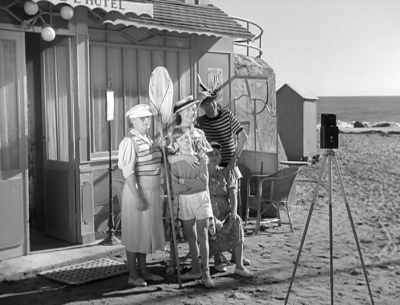
A small boy saunters into the dining room and the waiter, not approving of his admission, turns him around by the head and the boy simply continues walking out of the room. The gesture gives us the impression of a robot in the way the boy never breaks stride, but simply has his course of direction altered –like a wind up doll who changes direction as it collides into obstacles. In another funny moment Hulot’s body spontaneously imitates the movement of a wad of taffy on the pole of the ice cream stand as it slowly sinks downward under its weight.
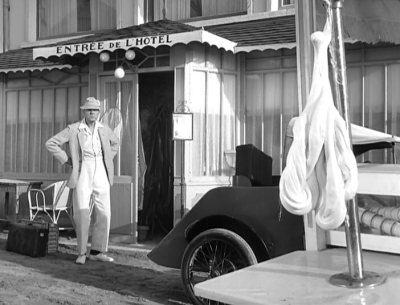
Hulot playing tennis is an hilarious example of the mechanical encrusted upon the body. For this and other sport-related mishaps Hulot is digging into his dance-hall days of comic physical humor satirizing sports and athleticism. His machine like movements on the tennis court (his serve for example) ridicule the game of tennis, which requires fluid movement and elasticity of the body. To make matters even funnier, he keeps on winning without ever having to move laterally (in a sports where lateral movement is especially crucial). It seems his unorthodox tennis style is too much for the rigidly minded vacationers who only know how to play tennis one way.
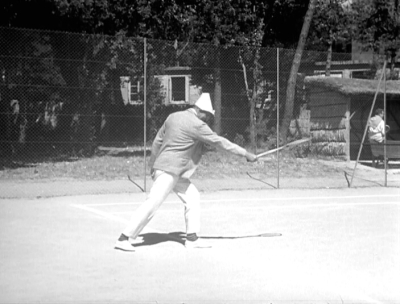
Perhaps the purest Bergsonian moment in the film is when Hulot is catapulted through the air like a bow and arrow into a body of water. It is a sublimely constructed gag. The rope towing Hulot’s car snaps. In the process of tying it back to the bumper both Hulot and the man driving the truck lose mistakenly switch off their hats. They both go back to their respective cars; Hulot, upon discovering that he has the other man’s hat, goes to tell the truck driver, but realizes that the man is about to start his truck, therefore decides to go back to his car. On his way back Hulot steps on the slack rope, just at the moment the truck drives forward, tightening the rope and sending Hulot skyward, like a cannon ball or an arrow.
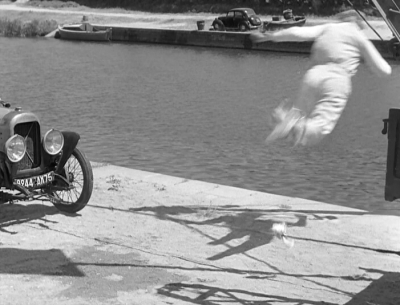
Hulot’s dogged determinism is a perfect reflection of Bergson’s Punch and Judy. There are two occasions where Hulot is momentarily defeated by outside circumstances but returns with a renewed vigor, expressed in his familiar pose of determination –his head down, body angled forward, and arms restlessly perched at his side. In both examples unexpected momentum causes Hulot to fall, forward in the first example and backward in the second. In the first instance a misplaced suitcase which Hulot takes to be the final step on a landing causes Hulot to go scampering through the front door, through the apartment and right on through the back door. The camera swish pans left along the outside of the house to follow his unseen figure, and there is a hidden cut on the movement to a similar panning movement that picks up Hulot exiting from the back of the house. He returns. In the second example Hulot helps a young, pert female camper carry her heavy knap sack. When they arrive at the cottage they are met by other eager campers, who are about to share a toast; Hulot joins them for a toast but the force of his body arching backward as he brings the cup to his mouth coupled by the weight of the bag causes him to go spiraling backwards through the cabin door and down a rugged terrain. He returns.
The Dancing Jack rule relates to the film as a whole. The vacationing people think they are “getting away from it all,” freed from the routines of life, when in reality their sense of freedom is an illusion. They are like puppets manipulated by hidden strings. These hidden strings take on the form of rules, habits, schedules, and, odd as it may seem, a radio. They are told when it is time to eat by a bell which rounds them up like a herd of cattle; they take their cue to begin eating only after the waiters begin to argue. The two waiters, one the owner of the hotel, are classic comic characters: rude, absentminded, easily distracted and frustrated by their role of servitude. The radio dictates when the tourists are to keep quiet (during the news broadcast). And when their day ends (they retire after the radio station signs of at 9:10pm). By force of habit and schedule they do exactly what they have done in years past: swim, play tennis, attend the annual picnic, play cards after dinner, etc. They are no more “free’ to do what they want on their vacation than in their normal lives, or perhaps even more rigidly programmed.
There are two examples of Tati following Bergson’s Snow Ball rule, the first being more a “topping” or extending of the gag, and the second being truer to Bergson’s model. The first example is the funeral scene. Hulot’s car stalls next to a cemetery where a funeral is taking place. He takes out his spare tire and places it on the ground, which is littered with wet leaves. The leaves cling to the runner tube and is mistaken by a funeral employee already carrying a wreath in one hand as a second wreath. Hulot being too polite to alert him of his error, allows the man to walk away and place his rubber tube on a nearby headstone. As a man in the greeting line walks by the tube begins to let out air; another man casts an accusing glance back at the man who he assumes is the source of the gas. Hulot is helped by three men attending the funeral to push start his Amilcar. Hulot, again too polite to let a good deed go unthanked, returns to thank them each. A man from afar sees Hulot greeting the three men and mistakes it for the acceptance line. Everyone follows him into the cue, and Hulot is trapped into standing there receiving condolences from strangers for a deceased he has never seen or met! Not content to rest, Tati’s creative mind takes the gag one step further; while a short lady wearing a feather-tipped hat shakes hands with Hulot the tip of her hat brushes under Hulot’s chin, causing him to let out a contagious giggle. As in many scenes, Hulot’s actions, whether directly or indirectly, cause a rigid or formal event to ‘loosen’ up into a freer expression of human interaction.
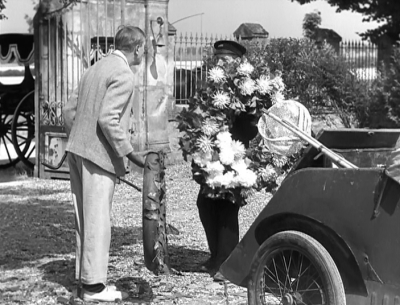
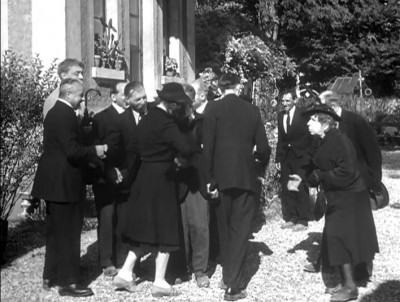
The second example has a causally related sequence more in tune with Bergson’s description of the Snow Ball effect. Hulot is, again, attempting to change a flat tire on his old car, which is parked on a decline. The jack slips, causing his car to roll backward into the car in front and setting it off down the hill. As Hulot is walking back, his unattended car calmly rolls past him and through an open estate gate. Once Hulot realizes the mishap he chases after his car into the gated private property, then comes running out in reverse chased by dogs. The scene momentarily cuts away –approximately two and a half minutes of screen time, but narratively it is now night time– reconnected by the sound of barking dogs as Hulot is still being chased and seeks refuge from the dogs in a dark shed. Unbeknownst to Hulot, the shed houses firework explosives, and when he lights a match he accidently sets off a fireworks display. The noise wakes up the sleeping vacationers one by one; one man inadvertently turns on a record player which is linked to the power of the electric switch, which triggers loud music and gives the chaos a festive mood. In perfect Tatian logic we evolve from a car jack slipping to a party!
Although the whole film/vacation is in effect a repetition, the best example of Bergsonian repetition is the case of the family man and his long distance business phone calls. The person in question is the man who is seen throughout most of the film wearing a white hat, white shorts, a white shirt, glasses, and carrying a camera. Though ostensibly on vacation, he is always receiving business calls at inopportune moments which take him away from his family: while on the beach, while swimming, as he is about to take a family photo, and as they prepare to leave for the annual picnic.
The best example of Bergson’s reciprocal interference of series rule takes place on the beach. Hulot first sees a young woman enter one of the portable change rooms, then sees the business man standing to the side and rear of the outhouse bent over and seemingly spying through a knothole. Hulot kicks him in the behind and scampers off. There is a cut to the victim reacting, and from this new angle we realize that he is not a voyeur, but was just framing a family photo. The victim walks forward to look for the culprit who kicked him and sees an innocent bystander leaning against another portable change room wiping sand off his feet. The business man interprets this gesture as a sign of the man’s culpability for the kick and he begins to stalk the innocent man, who slinks backwards and takes refuge into the change room. At this point the initial victim continues his stalking of the innocent man by staring into the change room, in effect turning him into the voyeur he was initially mistaken for by Hulot!!! In this situation we have two linked events capable of being interpreted in more than one way and, through coincidence or consequence, misinterpreted by the people involved.
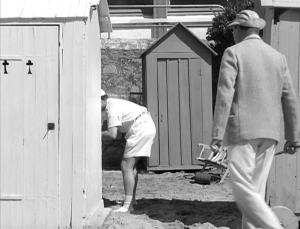
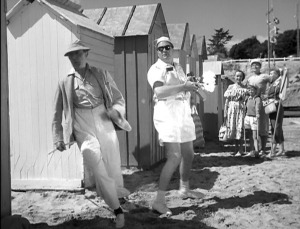
In this film all the characters are in a sense Bergsonian. The relationship between the waiters and the vacationers is, at best, one of tolerance. The relationship between the two waiters is one of “nose in the air” contempt. The relationships amongst the vacationers is, at best, superficial, and at worst, hypocritical. On the surface they act cordially to one another, but they do not aspire to anything more. When the vacation comes to an end they exchange pleasantries, business cards, telephone numbers, and make false promises of continued contact, but nothing of lasting quality will result, with the niceties to be repeated yearly, ad infinitum.
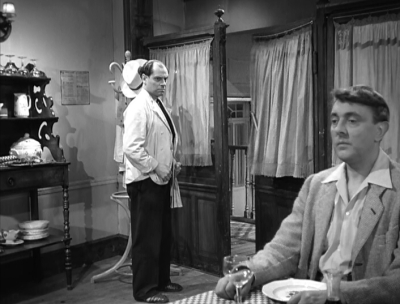
The two waiters become comic characters when their attention to Hulot causes them to become victims of their own absentmindedness. The shorter waiter is standing next to a seated customer, and his mind wanders as he catches a glimpse of Hulot staring at himself in the mirror. We hear the chimes of a grandfather clock and the waiter instinctively checks the time on his watch, causing him to spill a drink onto the customer. Later the same waiter takes offense when he spots Hulot sniffing at the dining room cutlery. While staring at Hulot he walks into the door as it is being opened by the other waiter (the head waiter). The head waiter himself begins to stare at Hulot and in the process mistakenly places his cap on a cane which is being held in the air by a man standing behind the hat rack (a variation of a Fieldsian gag). In another scene the head waiter drops his pen into the dining room aquarium (in a completely lateral thought, the set-up of an aquarium in the dining room area reminded me of the Mr. Creosote scene from Monthy Python’s Meaning of Life, knowing how influenced the British comedy troup were by Tati). The waiter pre¬pares to retrieve his sunken pen by rolling up his shirt sleeve, but then becomes transfixed by Hulot. In his trance¬-like state he sinks his other sleeved arm, watch and all, into the aquarium to recover his pen. Throughout the film the waiters are continually transfixed on Hulot and consequently display comic moments of classic absentmindedness.
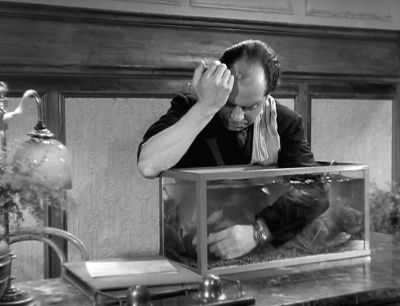
Does Bergson’s comic theory account for all the comedy in Tati’s film? In one sense Bergson’s theory does account for all the comedy in the film because, in accordance with mechanical rule number one, the entire holiday is a cumbersome ceremony imposing itself on the social body; as a whole it also conforms to Bergson’s law of repetition, and as stated earlier, the holiday ceremony fits neatly into Bergson’s Dancing Jack rule because of the “illusionistic” freedom it imparts to the vacationers. Therefore the shell of the film is pure Bergson, but Tati also uses non-Bergsonian principles to achieve comedy. The most obvious deviation is Tati’s brilliant use of sound. Tati uses sound in many ways, both as a comic effect in itself, and as an aid to the visuals. As a comic effect examples include the incomprehensible megaphone directions at the train platform and the running sound gag of the elastic-like ploink sound the dining room door makes whenever it is opened. As an aid to the visuals, examples include the use of amplified sound (slaps, sound effects, etc.), the backfiring and rattling sounds emanating from Hulot’s Amilcar; the “hollow” sound of the tennis ball as it bounces off a woman’s head, and duck like sound produced by the horn attached to the rolling spare tire.
There are numerous non-Bergsonian visual gags: the mischievous boy with the magnifying glasses; the scene where Hulot uses his towel to ‘dry’ a pole instead of his back (although this may be a case of Hulot’s inherent absentmindedness); the foreground/background gag where the waiter cuts meat slices according to the size of the incoming guests; the serviette-sleeve gag; and the scene where Hulot’s kayak folds in half. [5]
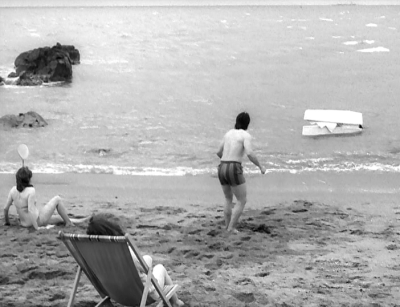
The ‘living’ encrusted upon a thing
In comparing Bergson’s theory and Tati’s film it is evident that there are many similarities between them. Whether these similarities are conscious on Tati’s part or coincidental is not important. We can however assume that Tati, who was an adult in France during Bergson’s lifetime (Tati lived from 1907-1982, Bergson from 1859-1941), would have certainly heard about Bergson’s ideas, if not actually read them. The affinity between Tati’s film and Bergson’s comic ideas suggests just how ‘cinematic’ Bergson’s writing about comedy were (as was his philosophy in general given its seminal role in the writing of Deleuze’s two cinema books); and just how influential and absorbed into film comedy Bergson’s ideas are. As an example, an excellent documentary I always show when I teach Film Comedy is Funny Business: Visual Humour, starring that other comic genius Rowan Atkinson, directed by David Hinton (1993, Great Britain). Atkinson plays a pompous, tweed-jacketed university professor who ‘explains’ film comedy and also all the character types and roles that animate his ‘theories’. The film, which succeeds at being both instructional and funny, is a literal template of Bergsonian ideas on comedy. Bergson’s ideas on comedy are ingrained into the fabric of film comedy largely because he does not explain why people laugh (which doesn’t concern comedians in the least), but is exhaustive and illuminating on what makes us laugh. Over the years repeated viewing of the film continues to reveal more similarities to Bergson, but one remains visible at the surface. Both Bergson’s theory and Tati’s film deal with comedy in a way that is social. What one remembers most from Bergson’s long and illuminating essay, apart from the sublime, influential idea –to not only Tati but all of film comedy, especially silent comedy, just think of Keaton, of the operational aesthetics–of something mechanical encrusted upon the living is that comedy is intrinsically human and of the social domain. What one remembers most from Tati’s film, apart from the lovable Mr. Hulot, is the supporting cast of individual yet composite comic social characters. Mr. Hulot/Tati, the spiritual decedent of the silent screen comedian, goofy, determined and eager to befriend, is symbolically, not accepted by most of the other tourists and is forced to spend his final moments alone amidst the children in a sand ditch. As with Bergson, a valuable social lesson is learnt.
Endnotes
1 We must keep in mind that Tati’s intention as a comic filmmaker is foremost to make his audience laugh, while Bergson’s intentions were didactic.
2 By ‘disguises’ Bergson includes everything from a change in hair color, skin color, and the red nose of an alcoholic, to clothing.
3 Bergson, p. 93. All quotes from Bergson are taken from his complete translated version, bound in a volume entitled Comedy introduced and appendix by W. Sypher. New York: Doubleday Anchor Books, 1956.
4 Brecht may have derived his “social gest” from this.
5 This is a reverse on Bergson’s theory because something mechanical, a boat, ends up looking like something living, a whale or a shark.



